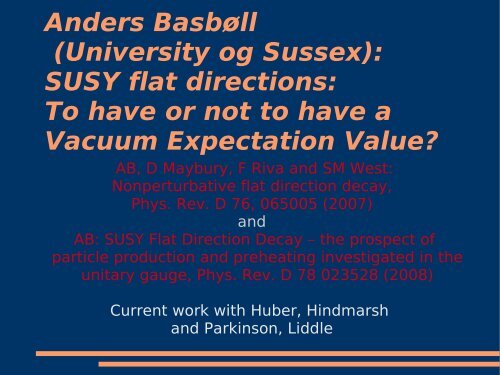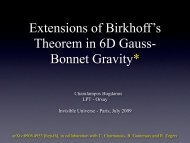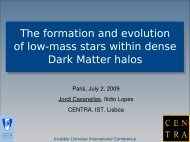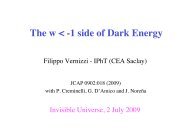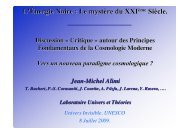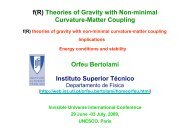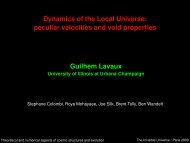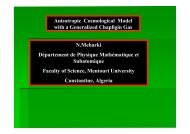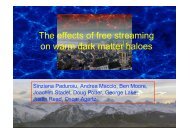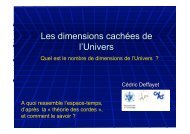Anders Basbøll (University og Sussex): SUSY flat directions: To ...
Anders Basbøll (University og Sussex): SUSY flat directions: To ...
Anders Basbøll (University og Sussex): SUSY flat directions: To ...
You also want an ePaper? Increase the reach of your titles
YUMPU automatically turns print PDFs into web optimized ePapers that Google loves.
<strong>Anders</strong> Basbøll(<strong>University</strong> <strong>og</strong> <strong>Sussex</strong>):<strong>SUSY</strong> <strong>flat</strong> <strong>directions</strong>:<strong>To</strong> have or not to have aVacuum Expectation Value?AB, D Maybury, F Riva and SM West:Nonperturbative <strong>flat</strong> direction decay,Phys. Rev. D 76, 065005 (2007)andAB: <strong>SUSY</strong> Flat Direction Decay – the prospect ofparticle production and preheating investigated in theunitary gauge, Phys. Rev. D 78 023528 (2008)Current work with Huber, Hindmarshand Parkinson, Liddle
Supersymmetry (<strong>SUSY</strong>) in 1 slide see Fayet, Tue (use time reversal)Every elementary boson has a fermionicsuperpartner and vice versa. (sparticles, gauginos)Multiplets with equal number of bosons andfermions. (partner with ½ lower spin – if possible)Spacetime enlarged by 2 anticommuting(Grassmann) coordinates. If local, Super Gravity.<strong>SUSY</strong> make all 3 SM couplings equal at a certainhigh energy – Grand Unified Theory (GUT) scale.High energy divergency in Quantum Field Theorycancelled: fermionic and bosonic loops haveequal contributions, opposite sign to each diagram.
Minimal <strong>SUSY</strong> SM (MSSM) table taken from Aitchison ArXiv: 0505105 Add Right Handed Neutrinos N: charges 1,1,0
(Super)potential and <strong>flat</strong>nessMSSM Superpotential renormalisable part Yukawas as in SM. HERE: generation defined bydiagonal <strong>SUSY</strong> breaking mass terms: 1/2 mi*|φi| 2Scalar potential: F and DtermT: symmetry generators Flatness: V=0 nonzero fields:All F and Dterms vanish V=0 (nonzero field values) only for exact <strong>SUSY</strong>(unbroken), no nonrenormalisable terms
Superpartners not seen Rparity: All particles and gauge bosons: +1.Sparticles, gauginos: 1. Can be defined: (1)^(2j+3B+L) Thus, superpartners can only be created ordestructed in pairs. Thus: Lightest Super Partner (LSP) oddson?favorite candidate as Dark Matter. WIMP: Weakcoupling, weak mass scale roughly fits therequireded density!
Flat direction evolution– from DineRandallThomasArXiv:hepph/9507453 Flat direction(QLD, example) Flatness easy: Colour, weak charge, hyperchargesum to zero m: dimension with canonical field Equation of motion with Hubble friction
Non renormalisable terms Nonrenormalisable term: M braking scale(Planck/GUT/?) Particle physics: Everything not explicitlyforbidden should be allowed, coupling order one. ALL terms respecting gauge invariance and Rparity will be considered (L,B conservation notdemanded couplings are small) below: terms breaking symmetry (k=1,2 Rparity)
Flatness and monomials: L1L2E3 L1L2E3 monomial: (νe*μ-e*νμ)τc SUL(2)xUY(1)invariant. Flatness: (νe,μ,τc) or (e,νμ,τc)=φ (e iθ 1 ,eiθ 2,e iθ 3):D=0 for all D-terms. Lifting <strong>flat</strong> direction with F-term: W4=L1L2E3N1: FN1=L1L2E3 and|FN1|^2=|L1L2E3| 2 : positive potential. A-term (scalar only) [A*eiθ A(νe*μ-e*νμ)τc+h.c]negative contribution for some phases.
Evolution during in<strong>flat</strong>ion Potential (n=k*m – k integer in Xk ) c: order unity. c>0 necessary (50%chance?) doesNOT work with Minimal Kähler Potential With H dominating, <strong>SUSY</strong> masses negligible Last term: nonrenormalisable <strong>SUSY</strong>breakingterms. Minimum: β order 1 constantMinimum could easily be of order 10 16 GeV!
End of in<strong>flat</strong>ion When H is of <strong>SUSY</strong> mass order (matter dom): Eventually mass term dominates, and the <strong>flat</strong>direction oscillates. Potential has phase dependent part: This gives Baryon number if BL not conserved by<strong>flat</strong> direction
Preheating – Kofman, Linde andStarobinsky hepph/9704452v2”Slowroll”Reheating Potential around minimum φ Interaction term with “massless” scalars Make shift: Quantise scalars: ∃ frequencies: nk(t) α Exp(μ*t) Energy to scalars at once: Preheating. Overproduction of gravitinos
Consequences of Flat Directions Allahverdi, Mazumdar+coauthorshepph/0603244v2 and othersFD induce masses to in<strong>flat</strong>on decay products: No preheating [no massless scalars] Energy is stored in the <strong>flat</strong> direction. When FD decays – Reheating. Reheating temp. 10^310^7 GeV (not 10^9GeV) Avoids the (lack of) gravitino problem FD itself a candidate for the In<strong>flat</strong>on!!!(LLE,UDD) Allahverdi et al. hepph/0605035v2Olive+Peloso hepph/0608096:Valid only if decay is nonperturbativeSPOILED if FD decays rapidly likely.
The framework Excitations of fields Lagrangian Excitations: mixed kinetic terms avoided, correctlynormalised Orth<strong>og</strong>onal transformation to make Uterm disappear: ”New” Lagrangian Diagonalisation
Nonperturbative particleproduction Conformal fields Equation of motion Mass matrixChanging eigenvectors
Particle production changing vacua Quantise field (change of creation/annil.~ α,β) initial: differential equations: Occ. numberNotice: adiabicity condition!Multifield: α,β>matrices Offdiagonal terms Rapidly changingEigenstates OREigenvalues >particlesNilles, Peloso, Sorbo:ArXiv:0103202Our framework:
LLE: <strong>flat</strong>ness Vacuum expectation values (VEV's) (almost) generic feature: Flatness independent ofphase Potential (no colour involved) Hypercharge: L: 2*(1) E:2so D_H=0 Weak charge: 1 up, 1 down: D_a=0
LLE – only VEV'sCovariant derivativeLagrangianF, W: Hypercharge, Weak field strength tensorsMixed kinetic terms – NambuGoldstone Bosons(unphys.)Only time derivative of phase: only 0'thcomponent of Gauge fields matter (index omitted)
Gauging Goldstones away go to unitary gaugeU(1) (hypercharge) transformationwithSU(2) (weak charge) transformationwithP³: 3rdPauli matrixnew VEV's (phase differences gone)with
Diagonal Goldstones removed define excitatations(incl. partners)still gives
All Goldstones removed
esults – LLE and UDD (seperately) Unitary gauge: phase differences removed Calculate M,U Jmatrix=0, No preheating!UDD exactly the same.3 phases, 2 gauged away.J=0, no preheatingwe found in first article: particle production prop. toderivative of VEVphase differences
(QQQ)4LLLE – VEV Fields “4”: (QQQ) 4 under SU(2) [isospin 3/2] Squarks with identical SU2charge chosen
(QQQ)4LLLE – other fields
(QQQ)4LLLE Preheating in both sectors! but depend on phase derivatives.J goes as Sqrt(g_i*φ/k)*σ i'for φ>>k(where σ iis a phase difference)
2 Flat <strong>directions</strong>: UDD+LLE Give VEV's to same fields as before! Now 6 phases – only 4 diagonal generators. However, it is 1 phase for LLE and 1 for UDD thatsurvives. Umatrix block diagonal: Fields and phase of LLEin one block. Fields and phase of UDD in anotherblock. J=0 – no preheating. Very encouraging for the cosmol<strong>og</strong>ical role of<strong>SUSY</strong> <strong>flat</strong> <strong>directions</strong>!
QLD+LLE – overlapping <strong>directions</strong> QLD and LLE can coexist. They can have VEVin the same field. A: relation between VEV's. ”Overlapping field” size: Root of squares . Preheating!
Problems with this picture Directions not independent. 17 (20) mass terms (Q,U,D,L,E,(N)) times 3 +Higgses but roughly 300 independent monomials Excellent catal<strong>og</strong>ue: Gherghetta, Kolda, Martin:hepph/9510370v2 Example: (QQQ)4L1L2L3E v (QQQ)4L1L2L2E Notice: VEV to first dir. => VEV to second dir. And similar equal Aterms QQQ4LLLE: k=7. Broken at n>=7? next slide.
(QQQ)4LLLE broken when? Without Right Handed Neutrinos (Rs): Picture: R_, broken by (QQQLLLE)² Correct: Q,L,E 18+6+3=27 complex d.o.f Breaks SM completely. 12 c.d.o.f removed (12gauge choices+12 non<strong>flat</strong> <strong>directions</strong>) 15 cdof left W4 includes QQQL, QULE:FQ,FL,FU,FE non trivial. 36 complex constrains Gherghetta, Kolda, Martin Lifted by V6 but Aterm NOT of order 4. Include Ns: Aterm: QQQLLLEN not n=4 still broken by W4 (including LLEN) Point: Gauge inv. monomials ~ FD's breaks down!
Investigation of potential Phase differences must have dynamical equationsof motion to create preheating (only Aterms). Effective mass terms must be negative for some<strong>directions</strong> for FD to matter at all. (or Aterm large)Kasuya, Kawasaki hepph/0606123v1 Roughly 300 monomials:LLE,UDD also LLE+UDD, so many possible terms Flattest: Q,U,E <strong>directions</strong> broken at W9 (V16) but, including N, at W6 (V10). Allahverdi+Mazumdar: General hierarchical VEVs Olive+Peloso: several large VEVs Goal: Write down potential to order V10 Estimate: (overcounting) 2,3 million couplings?
Counting correctly QQQijk=(SU(2) doublet) first look 27. correct counting: 8 combinations (1+1+1 twice).2+1 only 1 combination. (6 in all) (QQQ112+QQQ121+QQQ211)/Sqrt[3]=0 (QQQ121QQQ211)/Sqrt[2]=0 (QQQ211+QQQ1212*QQQ112)/Sqrt[6] free Notice: All 3 couplings Distribution: (Θ,σ 2 )=(0,1)gives 3 times (0,1/Sqrt[3]) in relevant direction. If GAUSSIAN: 3*N(0,1/Sqrt[3])=N(0,1) so okay! But would like to know there is 1 not 3 couplings.
More Counting(QQQ)2QU:Max 8(QQQ)*3(Q)*3(U) =72 dim.Min 12*3=36 dim [12 ways of assigning 3 gen to 4Q's with condition: not all same generation]Correct 18*3=54 dimNo way, to my knowledge, to explain this otherthan by investigating the basis vectors.
Combining monomialsGherghetta, Kolda, Martin:28 types of monomials basis (no generation index).AB: ~ 700 combinations
Choosing Normalisation All couplings order 1. But what is one coupling? (QQQ)4= 1 dim. 36 terms. Normalisation: 1. (norm of ε) eventhough 36 products of basis vectors. In QQQ4LLLE, L must be symmetrical in family L1L1L1 Norm 1 ( indistinguishability: below) L1L2L3+5permut/Sqrt[6] (no indist.) 1/n! (not n) for φ^n, φ SUPERfield (not field): HuHd^2: (H+ H )²2H + H H 0 uH 0 d+(H 0 uH 0 d)²
Statistical and numerical approach Statistical: Choose random couplings. Find minimum of potential. Monte Carlo. Try enough combinations to get a feeling of howmany superfields (and which) get large VEV's Analytical: Impose symmetries. Common couplings: m1/2,m0, A Will the <strong>flat</strong>test direction win? n=9 is formally <strong>flat</strong>test.
Conclusion <strong>SUSY</strong> Flat <strong>directions</strong> can have crucial influenceon (p)reheating and offer a very nice explanationof the gravitino problem, bary<strong>og</strong>enesis and evenoffer a ”known” particle as a candidate forin<strong>flat</strong>on. Preheating serious threat to this. The jury is still out! The potential must be investigated thoroughly!
Extra: Terms from Potential generalised Aterms: cross in Kähler deriv(Superpots) cross betweenSuperpots Kähler pot couplings generalised mass terms: Exponential prefactor cross in Kähler deriv (FD K, Infl W) Kähler pot couplings Dine, Randall, Thomas
Extra: Preheating details Quantum fluctuations of “massless” scalars Oscillator with varying energydef: amplitude , , , Mathieu equation: Instabilities: existence of band of frequncies: Bose enhancement:Exponential particle production This is a parametric resonance – all energytranferred to scalars: Preheating
Extra: (QQQ)2QU counting31 Min 6, correct 6, max 6 (210, add 001)22 Min 3, correct 3, max 6=6*1 [21 add 01])211 Min 3, correct 9, max 12=6*1[210 add001]+2*3[111 add 100])


